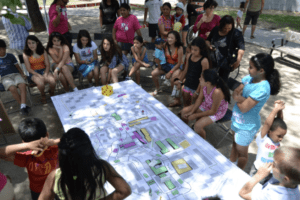This week I have been looking at past projects that Paisaje Transversal has been successful at using the gamification approach. In this post, I will explain the two other games that Paisaje Transversal partook in different neighborhoods in Spain.
Virgen de Begoña (VdB)
As I mentioned last week, Paisaje Transversal used a game called Trivial Pursuit in the neighborhood of Virgen de Begoña. They also created a second game called “¡Conquista el espacio público!”(Conquering public space!).
For the second game, Paisaje Transversal manufactured a new giant board game that would serve as an urban pedagogy tool. It included different types of games: Gymkhana, Pictionary, Taboo, Mimicry, or general questions. All the games were related to the VdB neighborhood and its public space. The objective of the game is not for one team to win, but rather for the whole neighborhood and its community to win. Additionally, the game included intergenerational activities, so that there were different types of activities aimed at different age groups. Therefore, it was convenient for the team to include insights from older people, adults, young adults, and children.
The objectives of “¡Conquista El Espacio Público!” and “Trivial VdB” games consisted of generating awareness for the need to establish strategies and actions of
appropriation for the improvement of residents’ closest shared environment. It is a strategy aimed at promoting citizen participation and emphasizing that the neighborhood can only regenerate when the people who live in it collaborate.

“¡Conquista el espacio público!” game (source: Paisaje Transversal)
Sant Miquel
Sant Miquel is a neighborhood in the City of Olot that, while having valuable resources and significant potential, has had a negative reputation among the rest of the City of Olot. For many of the residents, the neighborhood is now unappealing since it is one of the areas with the highest immigrant populations. Sant Miquel has suffered neglect during the last decades that has caused deterioration in the quality of the public space, due to infrastructures like large commercial and industrial parts. This has resulted in making it a comparatively unattractive neighborhood.
Joc de Barri (a game that Paisaje Transversal conducted) functioned as a recreational activity with the primary goal of raising awareness for the Sant Miquel project. Simultaneously, the game detected the neighborhood’s major value elements: its significant spaces and its elements of identity. These aspects, like the people and local events, are what give Sant Miquel its character. Residents learned more about the history of Sant Miquel, its locations, and the people that reside thereby answering these questions. As a result of the improvement activities, the participants began to collaborate and collectively decide on neighborhood suggestions.
Some of the main conclusions that were gathered from the Joc de Barri activity are explained below:
- Mobility appears to be one of the most important issues.
- Due to their scarcity and lack of adaptability, open spaces are another pressing concern.
- Avinguda Girona reappeared on other occasions, considering it necessary to improve the commercial activity of this street.
At Paisaje Transversal, they began to consider and be innovative with the gamification approach. This allowed them to handle their communities’ urban changes from an integrative and participative viewpoint. The gamification approach can transform the physical, environmental, and social reality of a neighborhood. At the same time, it can help to incentivize citizens to understand that they can be the protagonists of their neighborhood regeneration projects.
